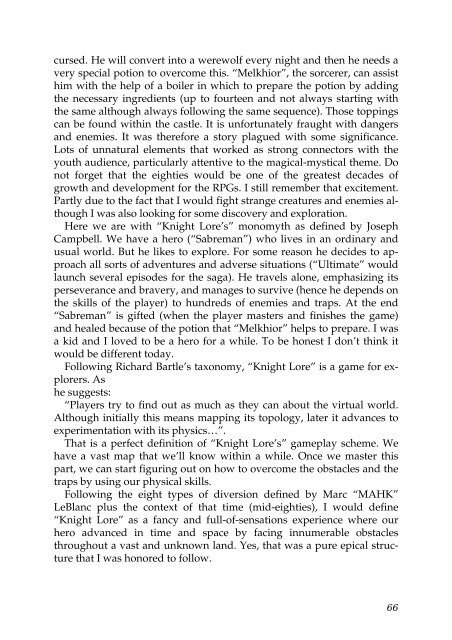Well Played 2.0: Video Games, Value and Meaning - OpenLibra
Well Played 2.0: Video Games, Value and Meaning - OpenLibra
Well Played 2.0: Video Games, Value and Meaning - OpenLibra
Create successful ePaper yourself
Turn your PDF publications into a flip-book with our unique Google optimized e-Paper software.
cursed. He will convert into a werewolf every night <strong>and</strong> then he needs a<br />
very special potion to overcome this. “Melkhior”, the sorcerer, can assist<br />
him with the help of a boiler in which to prepare the potion by adding<br />
the necessary ingredients (up to fourteen <strong>and</strong> not always starting with<br />
the same although always following the same sequence). Those toppings<br />
can be found within the castle. It is unfortunately fraught with dangers<br />
<strong>and</strong> enemies. It was therefore a story plagued with some significance.<br />
Lots of unnatural elements that worked as strong connectors with the<br />
youth audience, particularly attentive to the magical-mystical theme. Do<br />
not forget that the eighties would be one of the greatest decades of<br />
growth <strong>and</strong> development for the RPGs. I still remember that excitement.<br />
Partly due to the fact that I would fight strange creatures <strong>and</strong> enemies although<br />
I was also looking for some discovery <strong>and</strong> exploration.<br />
Here we are with “Knight Lore’s” monomyth as defined by Joseph<br />
Campbell. We have a hero (“Sabreman”) who lives in an ordinary <strong>and</strong><br />
usual world. But he likes to explore. For some reason he decides to approach<br />
all sorts of adventures <strong>and</strong> adverse situations (“Ultimate” would<br />
launch several episodes for the saga). He travels alone, emphasizing its<br />
perseverance <strong>and</strong> bravery, <strong>and</strong> manages to survive (hence he depends on<br />
the skills of the player) to hundreds of enemies <strong>and</strong> traps. At the end<br />
“Sabreman” is gifted (when the player masters <strong>and</strong> finishes the game)<br />
<strong>and</strong> healed because of the potion that “Melkhior” helps to prepare. I was<br />
a kid <strong>and</strong> I loved to be a hero for a while. To be honest I don’t think it<br />
would be different today.<br />
Following Richard Bartle’s taxonomy, “Knight Lore” is a game for explorers.<br />
As<br />
he suggests:<br />
“Players try to find out as much as they can about the virtual world.<br />
Although initially this means mapping its topology, later it advances to<br />
experimentation with its physics…”.<br />
That is a perfect definition of “Knight Lore’s” gameplay scheme. We<br />
have a vast map that we’ll know within a while. Once we master this<br />
part, we can start figuring out on how to overcome the obstacles <strong>and</strong> the<br />
traps by using our physical skills.<br />
Following the eight types of diversion defined by Marc “MAHK”<br />
LeBlanc plus the context of that time (mid-eighties), I would define<br />
“Knight Lore” as a fancy <strong>and</strong> full-of-sensations experience where our<br />
hero advanced in time <strong>and</strong> space by facing innumerable obstacles<br />
throughout a vast <strong>and</strong> unknown l<strong>and</strong>. Yes, that was a pure epical structure<br />
that I was honored to follow.<br />
66

















